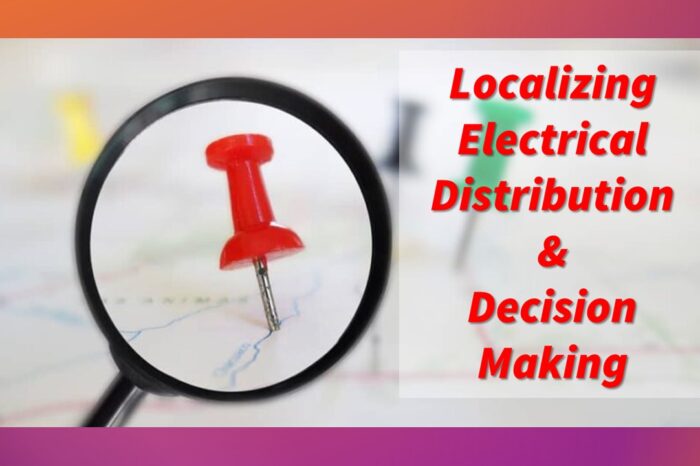Localizing Manufacturer and Manufacturer Rep Decision-Making and Planning
 The electrical market has become more nuanced in the past few years. National statistics, and perhaps national strategies, mean less than every before.
The electrical market has become more nuanced in the past few years. National statistics, and perhaps national strategies, mean less than every before.
Why? Consider:
- Geographic tendencies
- Concentrations of market / vertical segments
- Population shifts
- State tax policies which have influenced where industry has moved
- Near-shoring / re-shoring
- Energy costs
and more, including electrical industry consolidation and expansion affecting manufacturers, manufacturer reps and distributors.
Now all types of companies should be thinking about how to localize their strategies. The “one-size fits all” model doesn’t work (and yes, I know it is easier to operate.)
Earlier this fall, Desiree Grace, President, Americas, Cembre, Inc., was on a TED Magazine podcast talking about localization of decisions. The podcast discussed how increased localization of decision making could potentially help distributors as they “listen” to their market and tailor their offering. Obviously this goes against the grain when you think national organizations. After all, how often does Home Depot customize to a local market. And small and mid-sized manufacturers are challenged with supporting / growing within national chains unless they bring them the business.
And this is not to say that all distributors are like this. Nationals such as CED and City Electric are known for being locally responsive. Others to varying degrees. And many independents proudly promote the ability to make local decisions.
Now, Desiree is, what I call, a “thinker”. In fact, in 2017 she was awarded the NAED Trailblazer award winner. She’s been in the industry a number of years having worked for Eaton, Panduit and others. She knows the market. She’s even writing articles about this industry for over 6 years, in assorted industry publications.
So, after listening to her podcast, I reached out and we discussed how all elements of the channel could “localize” to optimize their business. Given how the US market is becoming more nuanced, yet the channel is becoming more consolidated, the thought was “could there be other approaches?”
The end-result? Desiree offered to start the discussion. Here’s here first article on localization … improving the planning process between manufacturers and manufacturer reps.
 “Recent articles in the news about B2C businesses as diverse as Barnes & Noble and Zara discussed moving customer experience decision-making back to the local level . These retailers reported positive results from consumers and employees. From a management perspective, the most important criteria, sales growth, was realized.
“Recent articles in the news about B2C businesses as diverse as Barnes & Noble and Zara discussed moving customer experience decision-making back to the local level . These retailers reported positive results from consumers and employees. From a management perspective, the most important criteria, sales growth, was realized.
This inspired the idea for a podcast on the topic with TED Magazine. Why not borrow a page from the B2C world?
On a DistribuTED podcast, titled Localizing Decision-Making, co-hosts, Scott Costa, Andrea Belk-Olson, and I, discussed how we can transfer these lessons from B2C to B2B.
While there are certainly fine organizations in the distributor community that have never deviated from this localized approach, the recent increase in mergers and acquisitions makes one wonder if our industry is going against the trend, and if we really should. A positive customer experience and ease of doing business can be a differentiator in a highly competitive world, and localizing that experience is much better than a uniform “one-size fits all” approach.
David Gordon asked me how a manufacturer could do this—create a localized approach and provide a positive customer experience. To my mind, there are 3 stakeholders that need an answer to the question, and one stakeholder we all answer to.
Industry Stakeholders
- Manufacturer Rep Agents
- Manufacturer Regional Sales Managers
- Distributors—Branch level
- End Customers
I will break down the Industry Stakeholders into a series of short articles. Let’s start with the Manufacturer Rep Agent (MRA) stakeholder community.
As a very wise mentor once told me, treat Rep Agents like Distributors. They are smart businesspeople and have a lot of local knowledge and relationships. It is still a business where relationships, trust, and nuanced local knowledge matter. Here are some best practices for the Manufacturer and their MRA.
- Collaborate on your distributor strategy. Whether you are intensive or selective, your main horse on a corporate or national level may not be the right distributor in that specific local market. Leverage that MRA’s local knowledge and listen to their suggestions about which horse(s) you need in your stable. Act on that knowledge.
- For our purposes, “Collaboration” is defined as mutual planning with input from the field level, not strictly “top-down.”
- See the end of this article for a short, anonymous, survey that will poll how often and how much manufacturers and reps collaborate.
- Provide data and solicit feedback. What products are selling in that market? What products are not selling? Find out why or why not. Local codes could impact your surface raceway or conduit position, for example. Maybe your packaging is a problem. Whatever the situation, combine their input with your data to jointly build an entire picture of the market, not just a snapshot. Then, act on the input. If you don’t already have a Manufacturer Rep Agent Advisory Council, start one.
- Empower your reps – They can provide distributor pricing, within certain parameters, without having to get every single price approved from the manufacturer. By doing this, you will have a nimble, responsive salesforce that can take orders quickly before your competitors have even opened their email
- Make sure your reps have the tools of the trade. Samples, marketing collateral, catalogs, cross-references, and training is all necessary. Conduct training for inside sales at the agency, also, not just outside sales.
- Communicate. MRAs should also know before your distributors about any upcoming price increases, product launches, personnel changes, or anything else that impacts the distributor or the end-user. Share best practices among agencies, let them know how other agents are performing, and what they are doing to be successful. If you have a supply chain issue, for example, be transparent. They ARE your sales force and need accurate information. By sharing information, you are arming them to with the tools they need to manage the local customers.
- Share your Org Chart. Align Marketing at the Manufacturer with the Rep Agent’s Marketing, for example. Make sure they have contact information for that all important warehouse and shipping team. These are just 2 examples, but points of contact within the Manufacturer are important, especially if your Regional leader is on a plane without WiFi. It’s never a good idea to have one relationship or one person be the information gatekeeper. There’s always a chance something could happen, and you simply don’t want to slow down response times or information flow.
- Plan and Review. The MRA is your sales arm. Pick your priorities for the upcoming quarter and year. Agree on the plan and review the plan. We all know that those monthly commission statements are important. This is a good time for a check-in to discuss progress against goals. If Distributor ABC isn’t trending as planned, why not? Can you course-correct? Is it an inventory issue, a marketing issue, a lack of joint sales calls? Much like home or auto maintenance, the problem is easier to address, and less expensive to address, if you catch it early.
If the MRAs clearly understand your strategic pillars and objectives, and demonstrate the ability to align, then they have earned the right to make decisions on the local level, at least within clearly communicated boundaries. Being fast to act will become part of your brand and differentiate you and your offering from your lumbering competitors. Being that trusted business partner who is easy to work with will enable local decisions that help you grow, and your successes and reputation WILL percolate up to the corporate level—just in time for the upcoming NAED regional. Your local branch manager will report positive progress, and that will translate to the national level.
Take our Manufacturer / Rep Collaboration survey.
our Manufacturer / Rep Collaboration survey.
It will take you less than 30 seconds to complete. No identifying information is requested.
You’ll be able to instantly see results. Once there are enough responses, we’ll have a follow-up article where we will share the results.
In the next article in this series, I’ll discuss how you can equip your Regional Management team to localize their approach.”
So, what do you think? Do you think Manufacturers and Manufacturer Reps collaborate they way that they could to optimize the business?
And Desiree will be at the NAED Eastern in a week. Seek her out to share your input.
Share your ideas below or email me and I’ll “sanitize”.





















